BMC J4 MAILVAN
Posted by Chris Graham on 16th January 2020
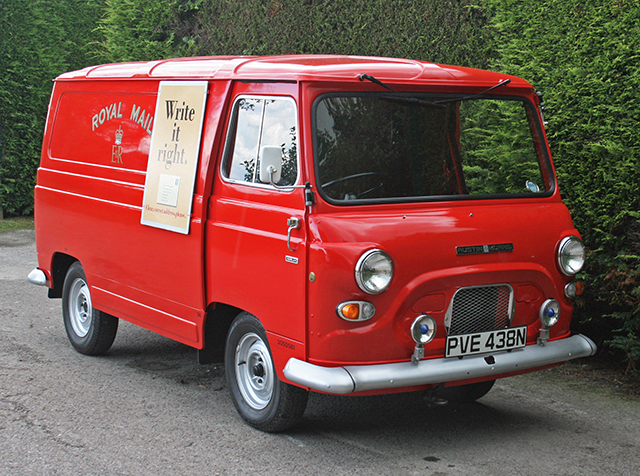
The Mills brothers’ latest LCV restoration has really been wowing the crowds at shows throughout 2019. Peter Simpson tells the story…
Once upon a time, red GPO/Post Office Morris (and later Austin-Morris) J4 mailvans were seen – and heard – everywhere in the UK. From 1961 to 1974 the J4 was the Post Office’s 150cu.ft van of choice, the ideal van for the job, and apart from a single batch of 250 Bedford CAs in 1964/5, they bought nothing else in that size.
Post Office J4s usually, however, had fairly short lives, and unlike the Minor vans, relatively few had second owners after the Post Office. When sold at auction, most Post Office BMC diesel vans were bought by specialist dealers whose primary interest was the engines and gearboxes. There was strong demand for these overseas, and some ex-UK Post Office diesel engines are probably still powering boats and plant on the other side of the world today. The rest of the van, however, was of no interest and invariably just scrapped.
The Post Office, being a large-scale van buyer, was also a large-scale seller. Auctions which had secured a prized Post Office disposal contract could expect a regular throughput of vans. Sometimes, the presence of a ‘Post Office’ auction attracted specialist dealers to set up nearby.
Red and yellow

Andrew (left) and Simon Mills with the latest addition to their collection of classic LCVs, a genuine ex-Post Office J4 mailvan
And that is where Andrew and Simon Mills, owners of the J4 featured here, come into the story. They’re based near Heathfield in East Sussex where for most of the seventies and early eighties, the local car auction had twice weekly sales including lots of Post Office vehicles of which the Mills family were regular bulk buyers. So much so, that their yard full of red and yellow vans was clearly visible from the air and, being on one of the flight-paths into Gatwick Airport, it was, in the days before on-plane computers, an official navigation guide for pilots!
Sadly, Heathfield car auction no longer exists, but the family van sales business – Rushlake Green Motors – most certainly does. It’s now run by Andrew and Simon and has a first-class reputation, though unsurprisingly, stock these days tends to be ‘van white’ rather than red or yellow…
Anyway, both brothers grew up surrounded by Post Office vans of the sixties and seventies, and have very fond memories of that time. They already owned a couple of vans of the types they used to deal in. However, a J4 mailvan was definitely on the wishlist, so when the opportunity to acquire a genuine Royal Mail J4 arose, they were interested…
One of only two?
PVE438N may well be one of only two Post Office J4s left, the other being officially preserved in the PO Museum’s Store at Debden, Essex. PVE, PO serial number 3050581, was new to the Head Postmaster at Cambridge (VE being a Cambridgeshire & Isle of Ely County Council registration) in September 1974. It was an ‘additional’ vehicle, in other words an extra one rather than a replacement, and spent a fairly typical six-year Post Office working life at Cambridge before being replaced (by a Sherpa) in October 1980.

From the rear. Post Office J4 rear doors had windows until 1967, after which solid doors were used
However, rather than being sent to auction, it was dent to the Post Office workshop in Southend, restored and then retained by Eastern Postal Region as a locally-preserved ‘Events’ vehicle, under the care of Huntingdon workshop. The Eastern Region’s preserved collectin also include a Morris Commercial LC5 240cf mailvan, a BSA Bantam telegram motorcycle and a Morris Minor mail van. However, as well as being preserved, the J4 went back into operational use once a year for a few weeks as a ‘Christmas Extra’ van.
This arrangement continued for over 20 years until 2004 when Royal Mail decided, at national level, to dispose of all locally-preserved vehicles. Accordingly, in February 2004 3050581 was sold at Manheim Auctions in Colchester with a final service mileage of 97,369.
It was bought from here by a Chelmsford dealer, but after that the history trail goes quiet – it effectively disappeared from view until November 2013 when it was advertised for sale on eBay. By this time it had been out of use for some time, though it was at least stored, on an Essex farmyard, undercover. The Mills Brothers saw it advertised, and arranged a viewing.
First impressions were mixed. On the positive side the chassis and underbody seemed good. It also started and sort-of ran with a battery connected.
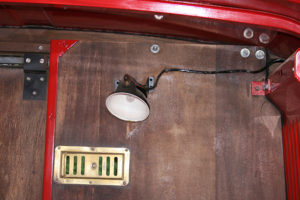
GPO spec loadspce light was often damaged in service, and rarely survived more than a few months on any vans which were bought from the Post Office for further use
However, the nine years away from the limelight had not been kind, and the bodywork was tired, battered and showing some worrying signs of corrosion, especially around the front. It was also filthy inside and out, and had clearly been neglected.
However, looking on the positive side again, because 3050581 had gone directly from Post Office ownership to Post Office preservation, all the now rare Post Office specific stuff such as Yale doorlocks, the fold-down passenger seat, loadspace interior light and external advertising boards were still with it.
The brothers still weren’t, though, 100% sure – Simon at first thought it needed too much work. However, they also recognised that, with the only other known survivor in a national museum, this might be their only chance to acquire a genuine Post Office J4. So, a price was agreed, and the J4 trailered to Sussex…
The work begins
The first job – getting the engine to run – was accomplished without too much difficulty. However, driving around the yard revealed a problem – it wouldn’t stay in first gear. It subsequently emerged that this had been an issue at Huntingdon which the staff there had never got to the bottom of. It was also, however, something which Andrew and Simon recognised straightaway from the hundreds of J4s they’d bought and sold back in the day. Someone had taken the gear linkage apart, but reassembled it without a small, easily-missed but vital shim. With this shim replaced, all was fine.
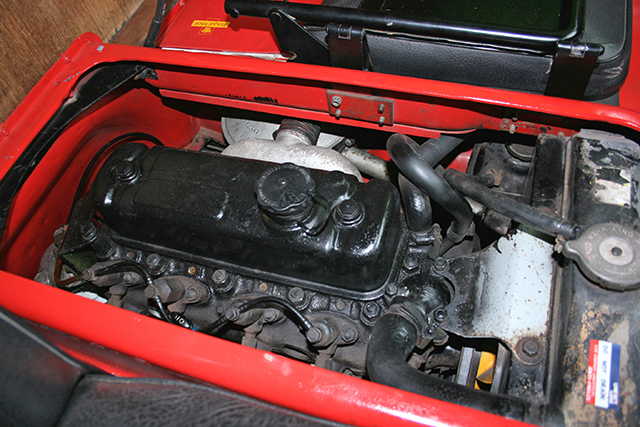
BMC 1.5 diesel was far from the fastest thing on earth, but was very long-lived, and though the vans are long-gone, many of these engines liven in plant and marine applications worldwide
Attention then turned to the bodywork which, it was thought, would require mainly dent and ding removal, a bit of localised rust repair, and a repaint. They started by attacking the front lower skirt with a grinder where there was some visible corrosion…
However, it quickly emerged that there was a lot more filled rot than expected; in fact pretty-much the whole bottom third of the van seemed to be covered in the stuff, and it was over an inch thick in places! All this had to be replaced with new metal, but of course replacement panels for J4s – or at least replacement panels that people actually need – just aren’t available.
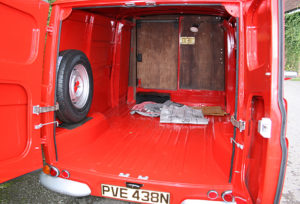
The loadspace was covered in dents and other minor damage when the van was bought, but is now immaculate. Note also the genuine Post Office wooden sliding door partition
At this point we need to introduce a third member of the team – Gordon Samuel, a highly skilled mechanic and bodybuilder who Andrew and Simon have known and worked with for “donkey’s years”. Gordon has an interest in old vehicle of all kinds but vans in particular, and was a great help throughout the project. It was he who made up the replacement panels and repair sections for the lower section.
The driver’s side door pillar was also rotted out and needed significant repair; again Gordon made the repair sections. The did, fortunately, find a new-old-stock nearside rear door; the original was beyond reasonable repair. The offside door, on the other hand, was pretty-much perfect and was probably renewed during the Post Office restoration.
Fortunately, the chassis proved to be every bit as good as originally thought. The floors, too, were solid, though the loadspace floor did need a fair amount of dent removal.
Having got a fully-equipped paintshop on site for use with the present-day van business Andrew was able, after extensive preparation, to repaint the van himself using two-pack on the outside but synthetic for the body-coloured interior. The rare Post Office spec internal sliding door between cab and loadspace was seized, but freed off fairly easily. A decent coat of Waxoyl concentrating on the known weak-spots concluded the body restoration.
Mechanical matters
As many readers will probably be aware, many of the J4’s mechanical underpinnings – and the weaknesses within it – are shared with the BMC A55/A60 saloon family. In this case the front lever-arm shock absorbers needed renewing, but the kingpins seemed to have been done fairly recently and needed only greasing. The brakes were renewed all through – shoes, wheel cylinders, pipes and master cylinder – and the clutch master and slave cylinders were also replaced. A major oil leak from the steering box was cured by fitting a new seal.

A steering column lock became compulsory on UK-spec vehicles from 1971. It’s a proper old-school diesel, with the traditional commercial vehicle engine stop knob…
As usual the ‘take forever but last forever’ diesel B Series engine was good and initially needed just a good service and new fuel filters, but once it was running again a couple of coreplugs started leaking and were renewed. The gearbox and back axle needed nothing beyond an oil change, clean-up and repaint. One road wheel having been distorted by driving with loose wheelnuts but a fellow J4 owner Andrew met at a show had a pair in his garage which he was happy to sell.
Finishing off
When it came to final detailing, Chris Hogan and the Post Office Vehicle Club were again able to help by advising exactly what Post Office transfers should be used – it emerged that those on the van when bought were too big. They also recommended Andrew Greening to supply same. Though the van was substantially complete in terms of Post Office ‘stuff’ when bought, the brothers have added a pair of genuine (and stamped as such) Post Office spotlights. One of these was bought on eBay, the other a lucky find at the Hellingly Festival of Transport autojumble.

The immaculate interior includes the correct and classic heavy-duty Post Office-spec footwell mats
The van was finally finished in May 2019; it was “just ready” for the HCVS Brighton Run but the brothers decided against entering until the van had been used a bit locally. After a shakedown period it was, however, out and about at several South East events in 2019 and picked up a number of significant awards including ‘Best Restoration’ at the Bromley Pageant of Motoring and overall winner at the Historic Commercial Vehicle Society Sprat & Winkle Run.
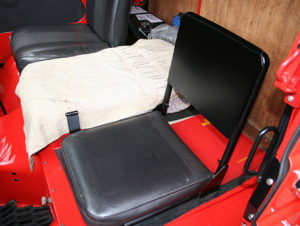
Fold down occasional use only front passenger seat, as access to the back was more important than the comfort of rarely-carried passengers
Andrew and Simon also took it to the Hellingly Festival of Transport and the Cuckoo Fayre at Laughton, near Lewes, among other events. Their next project, however, is something else from their past; an ex-Post Office Telephones 1973 Bedford HA van. Acquired as work on the J4 was at an early stage but stored until it was completed, it’s now “well underway” with an anticipated finish-date of “about this time next year.”
We look forward to seeing – and hopefully featuring – that one too. In the meantime, the J4 is absolutely fabulous.
J4 Mailvan history
From 1961 until 1974, the Morris and Austin-Morris J4 was the archetypical Post Office 150cu.ft mailvan and, apart from 250 Bedford CASPO 150cf. mailvans bought in 1964/5, the J4/JO4 was the only van of this size bought by the GPO and Post Office as a mailvan.
The first GPO J4s – a batch of 20 – were first registered on January 15 1961 as 583-602 BYY. 602 BYY had the lowest chassis number (103) in this batch and was probably one of the first production vehicles. A Crown Copyright photograph exists of a prototype van in August 1960 with a nearside door, but production vehicles were without side doors. The rear doors were initially glazed, but these were changed for solid rear doors from late 1967.
The other significant change was the adoption of diesel engines – the GPO was very keen to use them and had already tried a batch of JBs with diesel engines. The 1962 delivery was split between 250 petrol and 100 diesel J4s, but thereafter JO4s (the O indicating an Oil engine) were adopted as standard.
The vans were initially badged as Morris, but this changed in 1970 to Austin-Morris. As well as mailvans, the GPO and Post Office also used J4s in smaller numbers for the Post Office Telephones service as Area Planning & General Purpose vans. These were initially mid-bronze green and then, from 1968, golden yellow.
(Thanks to Chris Hogan of the Post Office Vehicle Club for this information)

On the move. The writer can confirm that this van drives every bit as well as it looks
To subscribe to Classic Van & Pick-Up magazine, click here





